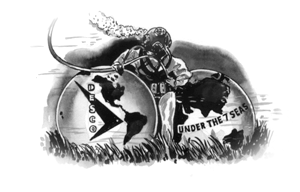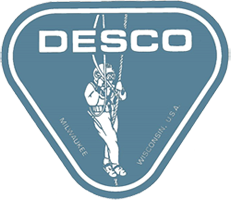History
 |
 |
 |
Diving Equipment & Supply Company (DESCO) was formed in 1937 as the manufacturer of the newly designed diving equipment by Max Nohl and Jack Browne. John Craig collaborated with Nohl and Browne, and participated in the research and developments. Mr. Norman Kuehn, a Milwaukee businessman, largely financed the new corporation. Browne and Nohl became its first full-time employees. Browne was also one of its shareholders. The company was set up in the rear of Kuehn Rubber Company on North 4th Street in Milwaukee. Norman Kuehn was made Vice-President of the firm.
In 1935, a Milwaukee diver, Max Gene Nohl, had received national publicity as the result of his salvage operations on a sunken steamship, the "John Dwight." This brought him to the attention of a Hollywood producer, Col. John D. Craig, who was interested in the possible salvage of the torpedoed Cunard liner, the "Lusitania," which lay in 312 feet of water off the Irish Coast. At that time, no equipment or reliable techniques were available for diving operations at such a depth, and it was obvious that such a project would require both physiological experimentation and an advance in diving equipment design. Nohl had already been working on diving equipment to work at the Lusitania’s depth. Additional support equipment would need to be designed and built for the project. Nohl using the suit design from his thesis as a starting point began experimentation on building the necessary gear. Jack Browne worked with Nohl and Craig to get the equipment ready. Browne and Nohl worked together on the design of a new type of lightweight, self-contained diving suit. In April 1937 Max Nohl contacted Dr. End about his development of Helium/ Oxygen decompression tables. Dr. End suggested using the recompression chamber in the basement of the Milwaukee County Hospital to test their theories. They worked with Dr. End to explore the promising possibility of preventing nitrogen narcosis and Caisson Disease (the Bends) by having the diver breathe a mixture of helium and oxygen rather than air.
The first result of this collaboration was the forming of Diving Equipment & Supply Company (DESCO) as the manufacturer of the newly designed diving equipment. Mr. Norman Kuehn, a Milwaukee businessman, largely financed the new corporation. Browne and Nohl became its first full-time employees. Browne was also one of its shareholders. The company was set up in the rear of Kuehn Rubber Company on North 4th Street in Milwaukee. Norman Kuehn was made Vice-President of the firm.
The second result was that, On December 1, 1937 in the cold waters of Lake Michigan, Max Nohl succeeded in diving to a depth of 420 feet, thereby breaking a depth record which had been held by a U.S. Navy diver Frank Crilley, since 1915. Nohl accomplished this feat using DESCO's new diving equipment and breathing a heliox mixture prescribed by Dr. End. As war neared in Europe the British Admiralty began placing more and more restrictions on John Craig’s expedition so it was finally called off in 1938.
Max Nohl not seeing a bright future for the fledgling company went on to other projects. The Edgar End/Max Nohl collaboration extended beyond the Lusitania project. In 1937 they designed and built a SCUBA rig, five years before the Aqua-Lung. After thorough testing in the hospital chamber and Lake Michigan the SCUBA rig and Dr. End accompanied John Craig to the West Indies to search for Spanish treasure ships in 1938-39. He served as the expedition doctor. From 1938 to 1940 Max Nohl was hired by Newton Perry to work on the Tarzan films starring Johnny Weissmuller. Accompanying Max to Florida were James Lockwood, and Ivan Vestrem. While at Silver Springs Max designed and operated a diving bell that allowed visitors to the park the opportunity to see the springs underwater.
Jack Browne kept DESCO going by designing and selling lightweight self contained suits. Through 1938 to December of 1941 the small firm plodded along. Jack experimented with new designs for breathing tanks and lighter suits.
With the outbreak of World War Two Mr. Kuehn urged Jack to go to Washington. “Tell the Navy what you know about diving suits. Show the boys what you have done and can do.” Jack did. In January of 1942 he headed east and returned with a $5000 order for three self-contained suits. That first order led to others until DESCO was producing more diving equipment than anyone else in the world.
World War II shifted the focus of the company to standard diving equipment production. The war effort brought large Navy contracts for diving equipment to DESCO. The company quickly became the largest diving equipment manufacturer in the world. Four diving equipment firms produced the bulk of equipment during the war. DESCO made over 3000 Mark V and Navy Helium Helmets during this period. The company’s research and development roots were not overlooked by the government. DESCO was contracted by the Office of Strategic Services (forerunner of the CIA) to design and build a compact oxygen rebreather. The result was the DESCO B-Lung. This unit, for the first time, permitted divers to swim freely under the surface, in the manner of SCUBA divers today, but without producing bubbles, which might disclose their position. Other projects included the Browne U.S. Navy Diving Mask, The Browne Lightweight Suit (Bunny Suit), and the Buie Mixed Gas Helmet. The government contracts included not only conventional hard-hat gear, but also weightbelts, shoes, knives, tools, recompression chambers, and miscellaneous items. By V-J Day, DESCO was producing more diving equipment than any other company in the world.
By 1945 DESCO had its own pressurized wet tank for research and development. On April 27, 1945, Jack Browne used this tank to "dive" to still a new record depth of 550 feet of seawater. Mr. Browne used a U.S. Navy Lightweight Diving Suit (bunny suit) for the tank dive. As in the case of Nohl's earlier dive, he breathed a heliox mixture under the supervision of Dr. End. Both dives were milestones in the development of modern techniques of mixed-gas diving. During this time Max Nohl left DESCO to pursue other interests. He would return briefly in the early 1950’s.
In 1945 the company named changed to Diving Equipment & Supply Co. The end of the war brought a slowdown in the diving market. Foreseeing this situation the company had begun moving into the recreational market. Products included search boards, water skis, masks, fins, the DESCO Airmaster SCUBA regulator, and recreational rebreathers. A sporting goods division is formed with J. F. Fulop as sales manager.
In 1947 Jack Browne and Norman Kuehn sold the company to Alfred Dorst, E. M. Johnson, Paul Hoffman, and Irwin Knoebel. Johnson was general manager of DESCO during the war. Max Nohl at the time was looking to calm down his life a bit and he accepted an offer to return to DESCO as a technical advisor.
After the Korean War, which again brought an increase in U.S. Navy contracts and orders, the ownership changed hands several times, and by 1960 it went out of the sporting goods business. Ever since, it has concentrated solely, as it did at the start, on the design and manufacture of commercial and U.S. Navy diving equipment.
In May 1966, DESCO was purchased by Thomas and Marilyn Fifield. Mr. Fifield was an attorney and Mrs. Fifield served on several boards in Milwaukee. In 1968 DESCO moved to its present address at 240 North Milwaukee Street in Milwaukee. Mr. Fifield was responsible in the 1960's for the design and development of the DESCO Diving Hat, which remains a standard piece of modern equipment for diving with air in relatively shallow water where mixed gases are not needed. Also the company has continued to improve and manufacture its famous DESCO Full-Face Mask, which originated in the early design efforts of Jack Browne and Max Nohl. This mask has probably been used in more total hours of commercial diving than any other piece of equipment ever made.
The company ownership changed again in 1997 with the purchase of DESCO from Mr. Fifield by Richard Koellner. Under Mr. Koellner the company has expanded its representation of other firm’s products that complement DESCO’s product line. DESCO is an importing distributor for Viking Drysuits and accessories. In 2002 DESCO became the dealer for Composite Beat Engel DeepSea Lightweight Diving Helmets in the Americas.
Since 1990 we have made significant upgrades to the DESCO Air Hat, and we introduced the Bob Kirby inspired Browne Commercial Diving Helmet. The newest offering in the classic helmet line is the Stillson Concept Diving Helmet. In 1915 Gunners Mate G. D. Stillson issued a report on the condition of diving in the U.S. Navy. Contained in the report were drawings of a preliminary design for a new standard helmet. Those drawings were the precursor to the US Navy Mark V Helmet. DESCO took those concept drawings and turned them into a real functioning helmet.
The expansion of hobby collectors and diving enthusiasts has brought resurgence in demand for classic helmets and repair and restoration services. We provide repair and parts services to the collector and enthusiast market.
DESCO is a recognized resource for writers, artists, historians, and film makers. DESCO manufactured the helmets, weightbelts, control valves, shoes, and knives used in the movie Men of Honor. DESCO also provided equipment to the films The Deep, and The Legend of Sawtooth Island. We loaned a helmet to Milwaukee County for a special exhibit at the Horticultural Conservatory Domes. We have provided technical information and photographs to artists and writers for projects.
Diving Equipment and Supply Company Future
DESCO is looking towards the future at new products and services. As the industry evolves DESCO will keep pace with new products and assure that our current products meet or exceed industry requirements. DESCO will continue to explore new product possibilities and marketing opportunities to bring our customers top quality equipment and services.
Diving Equipment & Supply Company DESCO Corporation Location Chronology
From Milwaukee City Directorories (*) and other sources
| 1938 | N.L. Kuehn Co. Building 1053 N. 4th Street |
Jack Browne Pres., N.L. Kuehn VP, E.M. Wanacek Sec/Treas |
| 1942* | 922 N. 4th Street | John W. Browne Pres. N.L. Kuehn Sec/Treas. |
| 1944-45* | 1319 N. 3rd Street | E.M. Johnson, Manager |
| 1946-1947* | 1119 N. Water Street 417 W. Highland Ave. (Shop) |
Norman Kuehn, Pres., Jack Browne, VP, Earl Wanacek Sec/Treas |
| 1949* | No Listing in directory | |
| 1949* | 234 N. Broadway Ave. | Alfred Dorst, Pres., Burnett C. Flint, VP, Paul A. Hoffman, Sec., Irwin Knoebel Treas, |
| 1955* | 234 N. Broadway Ave. | |
| 1956* | 234 N. Broadway Ave. | J.E. Fulop, Pres., Paul Hoffman, VP, Irwin Knoebel, Sec/Treas |
| 1957* | 212 N. Broadway Ave. | |
| 1959* | 212 N. Broadway Ave. | |
| 1960* | 212 N. Broadway Ave. | Ervin J. Hoeft, Pres. |
| 1962* | 212 N. Broadway Ave. | Ervin J. Hoeft, Pres. |
| 1964-65* | Listed as DESCO Diving Equipment & Supply Co. Erwin J. Haeft Pres. Cross checked personal listing for Ervin J. Hoeft and he is listed as president of DESCO. |
|
|
Chronology was checked in City directories to this point. |
||
| April 1968 | 240 N. Milwaukee Street | Thomas B. Fifield Pres. Marilyn Fifield V.P. Bernice McKenzie Manager |
| 1997 | 240 N. Milwaukee Street | Richard C. Koellner Pres. |
